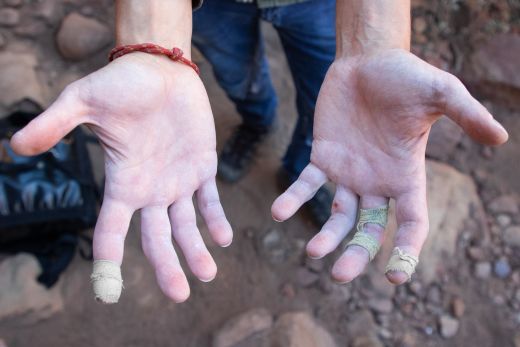It doesn’t matter whether you’re into steep limestone, granite faces, or sandstone splitters – tough and durable skin is essential to climbing success. Besides ensuring that you have dry and uniform contact patches (fingertips) for generating maximum friction, good skin allows you to bear down on holds with more force and to put in more attempts before it’s time to call it quits. It’s no wonder then that elite climbers obsess over their skin and generally have thoroughly dialed-in skin care regimens. If you’re reading this, you have probably come to the same realization, and you want to know how to develop and maintain good climbing skin. Well, you’re in the right place. Read on, and you’ll learn everything there is to know about climbing skin care and how to develop a protocol that suits your skin type.
- The skin’s wear-and-recovery process
- Know your skin type
- How to fix damaged skin
- Skincare products
- Tips for making your skin last longer
The skin’s wear-and-recovery process
Knowing how to care for your skin starts with understanding the cycle of wear and regeneration – it’s through this process that you grow stronger and more resilient skin.
What does good climbing skin look like?
Good climbing skin is leathery and tough – resistant to heavy wear, cracks and splits – and supple enough to heal quickly. This means that you should have some calluses, but these should not be much thicker than the skin between them. Calluses that are much thicker than the surrounding skin can tear off and create flappers, and tips that are too hard can split and crack. Durable skin strikes a balance being tough and pliable.
How do I get that kind of skin?
While it’s important for your skin to be dry when you climb, you actually want it to be supple and elastic between sessions. Why? Because thicker, tougher skin is the result of your skin’s healing process. When subjected to repeated pressure, friction, and irritation, your skin naturally grows thicker to help it stand up to future wear. The problem is that skin can only heal properly when it’s properly hydrated, and all that chalk dries out your skin. What this means for climbers is that you actually have to get some moisture back into your skin after a session. Exactly how much moisture depends on your skin type.
Know your skin type
Everyone’s skin is different, and you have to figure out what type of skin you have if you’re going to give it the right care. Skin can be very dry, very sweaty, or somewhere between these two extremes.
Dry skin
Dry skin is slow to heal and prone to splitting, so if you have this type of skin, you are going to have to moisturize – possibly quite regularly. Figuring out what kind of moisturizer works for you and how regularly to use it could take some trial and error. People with relatively normal skin might only need a light non-greasy moisturizer like Friction Labs Restorative Hand Cream, while those with very dry skin will likely need an oil-based moisturizer or even a balm. Besides helping lock in moisture, the ingredients in these products have anti-inflammatory and anti-bacterial properties that can help damaged skin heal faster.
The problem with beeswax-based balms is that they are greasy, meaning that you don’t want the stuff on your hands just before you start climbing. For people who need it, the best strategy for using balms is to save them for after your session and when you go to bed. During the day (especially in the hours just before you climb), it would be best to use a regular water-based moisturizer. Besides giving more thought to their choice of moisturizer, people with dry skin also need to be careful about the kinds of soap they expose their hands to. Harsher soaps like dishwashing liquid can dry out your skin.
Sweaty skin
Climbers with moderately sweaty skin still need to use a light non-greasy moisturizer although they might choose one with some kind of antiperspirant in it. This is where a product like Rhino Skin Performance (4% Methenamine) makes a lot of sense. You can put it on after a session (and after washing your hands and taking care of any little nicks and cuts) and then again six to eight hours before your next session. With the 2-in-1 approach, there’s no need to apply one kind of product and then another.
Climbers with very soft or sweaty skin, on the other hand, might have to forego moisturizing completely. Their solution will be to use a stronger antiperspirant, like Rhino Skin Dry to help their skin toughen up between sessions and to keep it dry during a session. They will likely still need to use a bees-wax balm to help heal knicks and cuts, but it will be applied only as a spot treatment. Lastly, there are those people for whom even 8% methenamine isn’t enough. Climbers with tips this sweaty have to get drastic, and that means using a stronger methenamine-based product or antihydral (typically applied only to your fingertips and used with caution).
How to fix damaged skin
Besides knowing what kind of day-to-day maintenance your skin type needs, you should also know what to do if you split a tip, tear a flapper, or earn yourself a gobie.
Worn tips
Granite and coarsely-grained sandstone can be very rough on your hands, especially your fingertips. If you have ever reduced your tips to soft pink little pads, you know exactly what I’m talking about. Hopefully you don’t allow your tips to wear this thin, and you only have to content with some ragged little cuts and nicks. These can be smoothed down with an emery board or sandpaper before moisturizer is applied to help the healing process. If, on the other hand, you have worn your skin too thin, you will likely need something to dry out the top layer of skin, which will then denature to provide a protective layer for the softer live skin underneath. A stronger drying product like antihydral cream or Rhino Skin Tip Juice will do just that, but you have to be careful to apply it only to your tips. If you get it in the crease of a PIP or DIP joint, it can cause the skin to split.
Hard calluses and tips
And then there is the opposite problem: skin that is too hard and thick. What’s wrong with hard, thick skin, you ask. Nothing, as long as it is also pliable. The problem is that thick skin can become too hard, making it susceptible to cracking and splitting. Also, when the thickness of your skin is very uneven (as can happen when you have thick calluses), it can tear off in flappers. The solution is to file down thicker calluses and tips so that your skin’s thickness is more uniform. For this purpose, you can use an emery board or sand paper with a coarseness somewhere between 80 and 120 grit. Filing down your tips will also remove little flakes and nicks that can catch on the rock and rip.
Split tips
Splits and gobies require more intensive care in that they are open wounds and have to heal properly. With a split tip, you first have to trim off any dead skin around the split and then file down any remaining hard skin until you reach soft healthy skin underneath. Then, wash the area with soap and water. Once the wound is dry (You can pat it dry if you need to), apply a beeswax-based balm and cover it with a band aid or bandage. If the affected area turns white while covered, take the bandage off and let it dry until the skin is pink again.
If the split is somewhere other than right on your fingertip, you can try super-gluing it together (Dermabond is designed specifically for this purpose). Just know that this is a last resort tactic that you should really only employ if you have a few days left in a trip. The aforementioned protocol of removing dead skin and then applying a balm and bandage is generally a much better solution if you can give a split a few days to heal. Another less orthodox tactic is to put chalk into a split tip to stop any bleeding. This can buy you a few more attempts on your project if you feel like it’s now or never.
Gobies
Gobies are the unsightly skin abrasions that afflict crack climbers. While some climbers see these little nasties as a badge of honor, they can also be a pain to deal with. As with split tips, you first need to cut away any dead skin and then clean the area with soap and water. But after that the protocol differs. Given the larger surface area of the wound, a scab would normally form if left to do its own thing. The problem with scabs is that while they do allow an undressed wound to heal, they can also result in a wound taking longer to heal. If, instead, you treated the wound with an antibiotic ointment (Neosporin or Polysporin) and then covered it to keep it moist, the wound would actually heal faster. You just need to make sure that you use an adhesive bandage with a non-stick pad large enough to cover the wound and the skin around it.
Flappers
Even if you sand down your calluses, it’s almost inevitable that at some point you’ll get a flapper. When you do, this is how to treat it. First, cut off the loose skin with a pair of scissors or clippers – taking off as much as possible to reduce the chances of any further tearing. Then, wash the affected area with soap and water, and let it dry out for a bit. Why only ‘a bit’? Because if it dries out completely, the new skin can crack. To avoid this, you will need to apply some kind of healing balm and then cover it with a self-adhesive bandage. Finally, if you want to continue climbing, I recommend adding some climbing tape on top of this and then doing what you can to avoid putting pressure on the area. Obviously, there’s a better chance of it healing properly if you can avoid using that hand for a while.
Skincare products
By categorizing skin as dry, very dry, sweaty, or very sweaty, I have made some generalizations. While these will allow for some useful guidelines, the reality is that no two people have the exact same type of skin. Even if your hands are usually as dry or sweaty as your friend’s, you might find that what works for him doesn’t work for you. The point is that you have to figure out what products suit your skin and then learn how to use them in a way that gets you the best results.
Antihydral cream
Antihydral cream is the strongest antiperspirant available and should be used with caution. While it works wonders for some climbers, shutting down overactive sweat glands and inducing skin to thicken, this stuff is too potent for most climbers. When applied to relatively normal skin, antihydral can cause your skin to become so hard that deep cracks form. The net result is a long slow healing process that can mean weeks of lost climbing time. Bottom line: be careful with this product even if your V12-climbing buddy swears by it.
Caution: The smartest approach to using any new product is to start with a small amount applied just where you need it, and then ramp it up after a few weeks if it works for you.
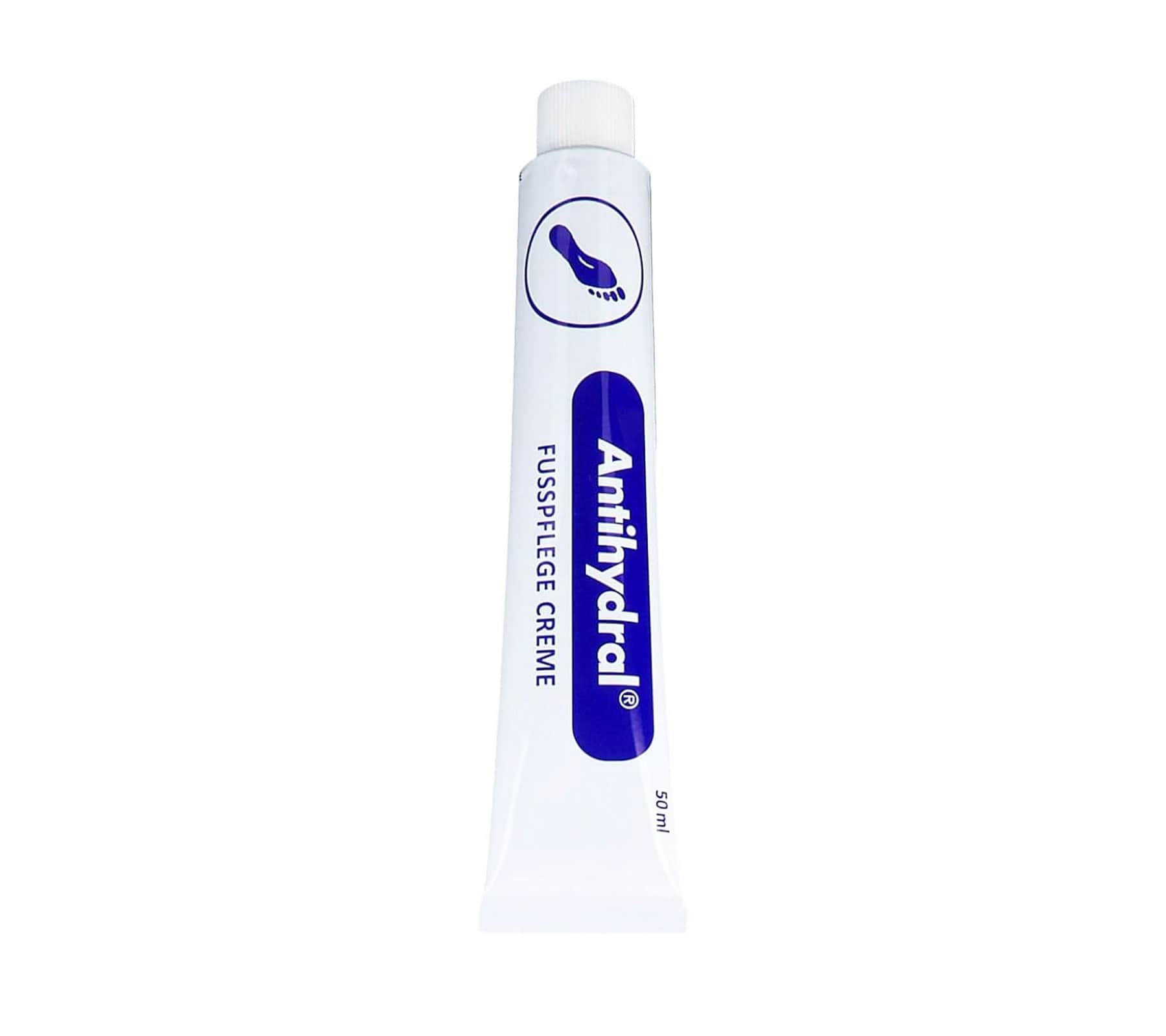
Methenamine-based antiperspirants
If you have sweaty skin but don’t need something as hardcore as antihydral cream, you’ll probably find that there’s a methenamine-based antiperspirant that fits the bill. One company, Rhinoskin, actually produces a range of such products with different concentrations of methenamine. Rhino Skin Tip Juice (12% methenamine) is used in a similar way to antihydral – just on the fingertips. Rhino Skin Dry (8% methenamine) can be applied to your fingers and palms to keep skin dry during and between sessions. And Rhino Skin Performance is actually part moisturizer, part antiperspirant (4% methenamine), making it a good solution for a lot of people.
- Rhino Skin Dry (Buy at REI)
- Rhino Skin Performance (Buy at REI)
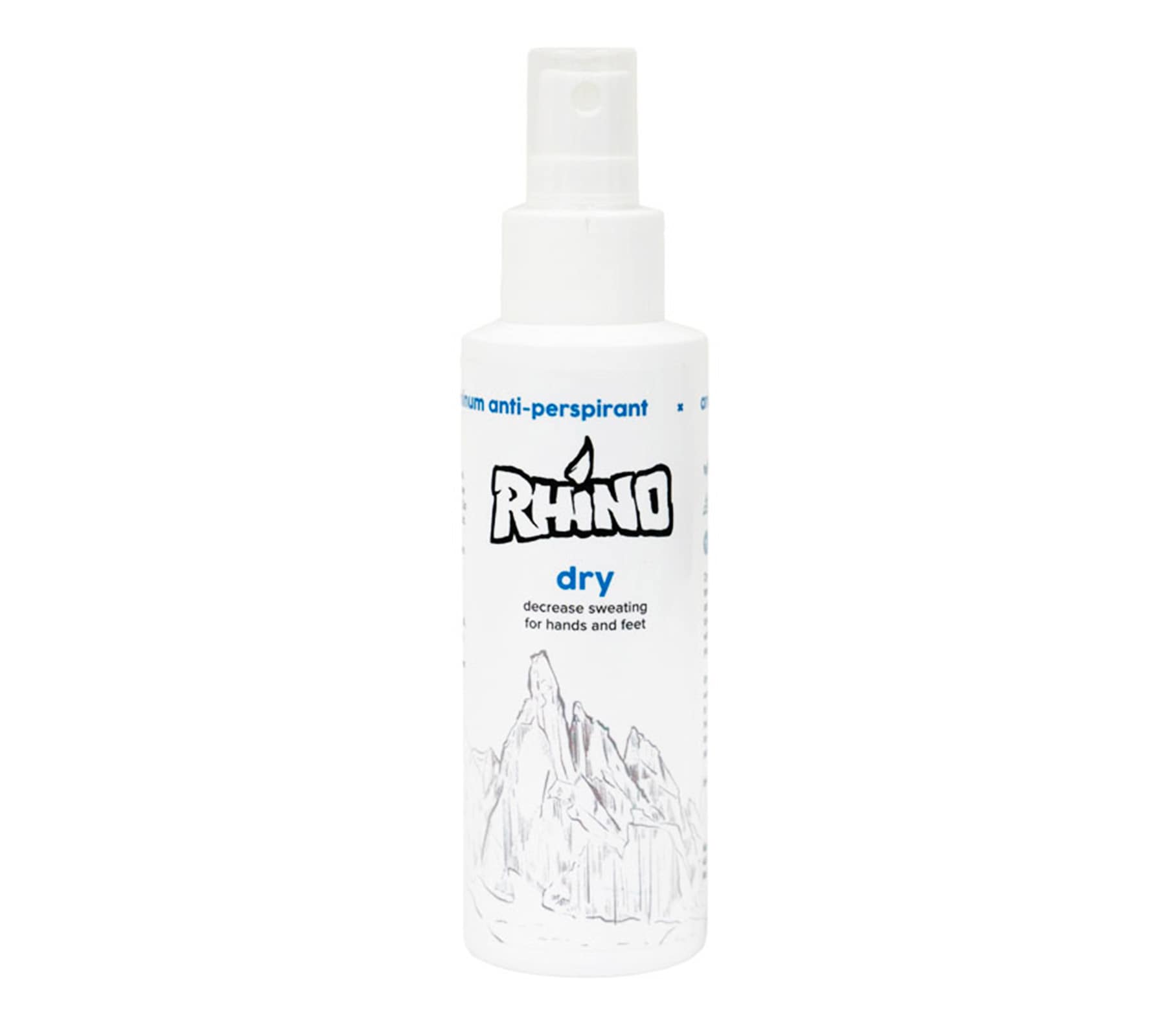
Moisturizers
Most climbers will benefit from using some kind of moisturizer. For those with average skin, the best option is likely to be a light water-based lotion. These products rely on humectants like sorbitol and glycerin to keep your skin hydrated and are completely non-greasy. If, on the other hand, your skin is on the drier side, you will probably need to use an oil-based moisturizer like Rhino Skin Repair. These oil-based creams typically contain ingredients like shea butter and coconut, which lock in even more moisture, but they are not without their downsides. Even though these products claim to be non-greasy, they do have a slightly greasy feeling to them, meaning that you’re probably not going to want to use them right before or during a session.
- Rhino Skin Repair (Buy at REI)
- Friction Labs Athletic hands (Buy at REI)
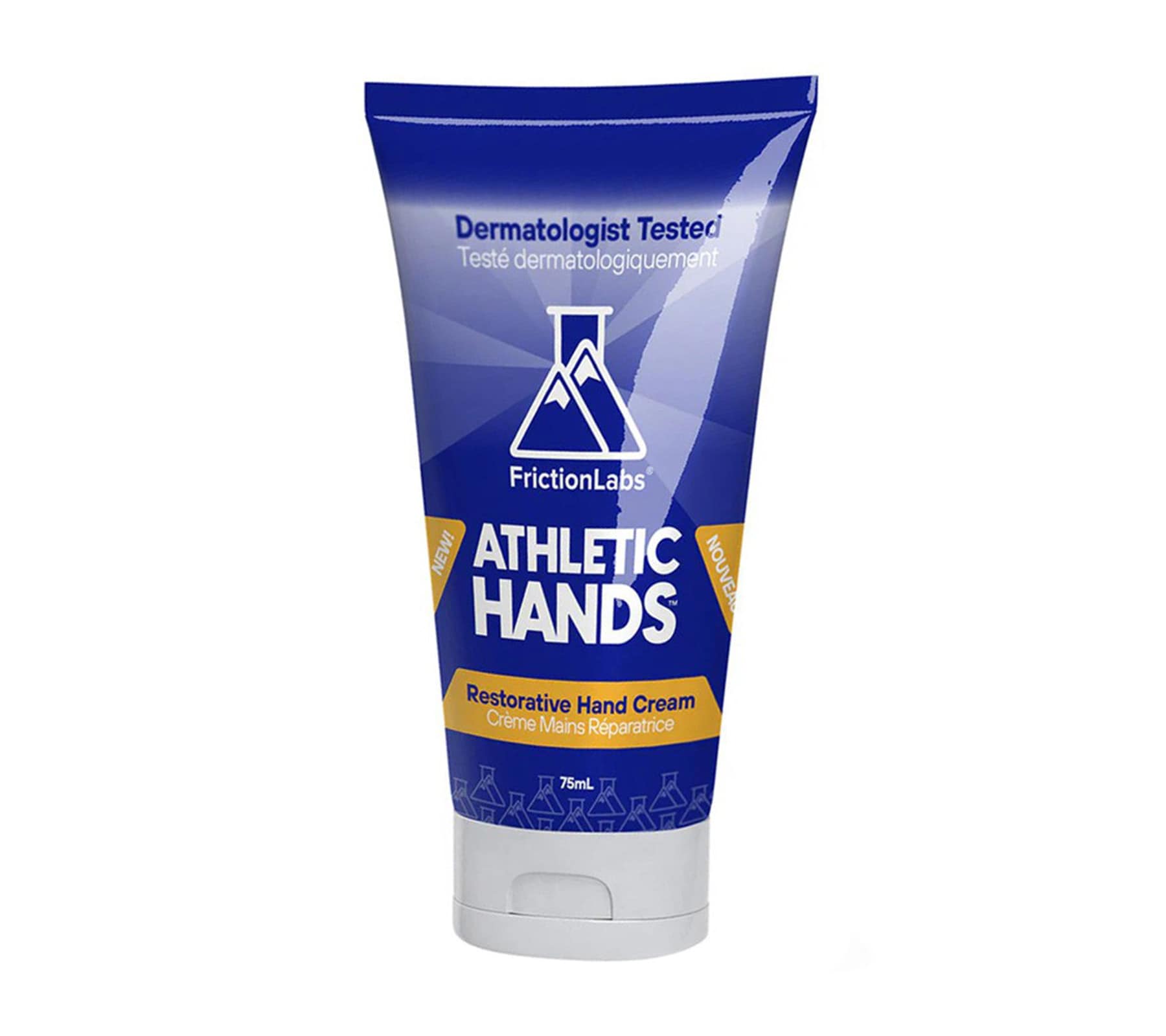
Healing balms
Whereas moisturizers are designed to hydrate dry skin, balms are designed to help damaged skin heal quickly. And they can do this because they contain large amounts of beeswax and shea butter – antioxidant-rich ingredients known for their antibacterial and antiinflammatory properties. But the advantages of these purely oil-based products don’t end there. The thick greasy consistency of balms also means that they act as a protective barrier against bacteria and lock in the moisture needed to speed along the healing process. The only downside to beeswax-based balms is that they are inherently greasy, which means you wouldn’t want to apply these in the few hours before a session. Climb On! Is the original, but today there are many similar products.
- Climb On (Buy at Climb On)
- Get Giddy (Buy at Get Giddy)
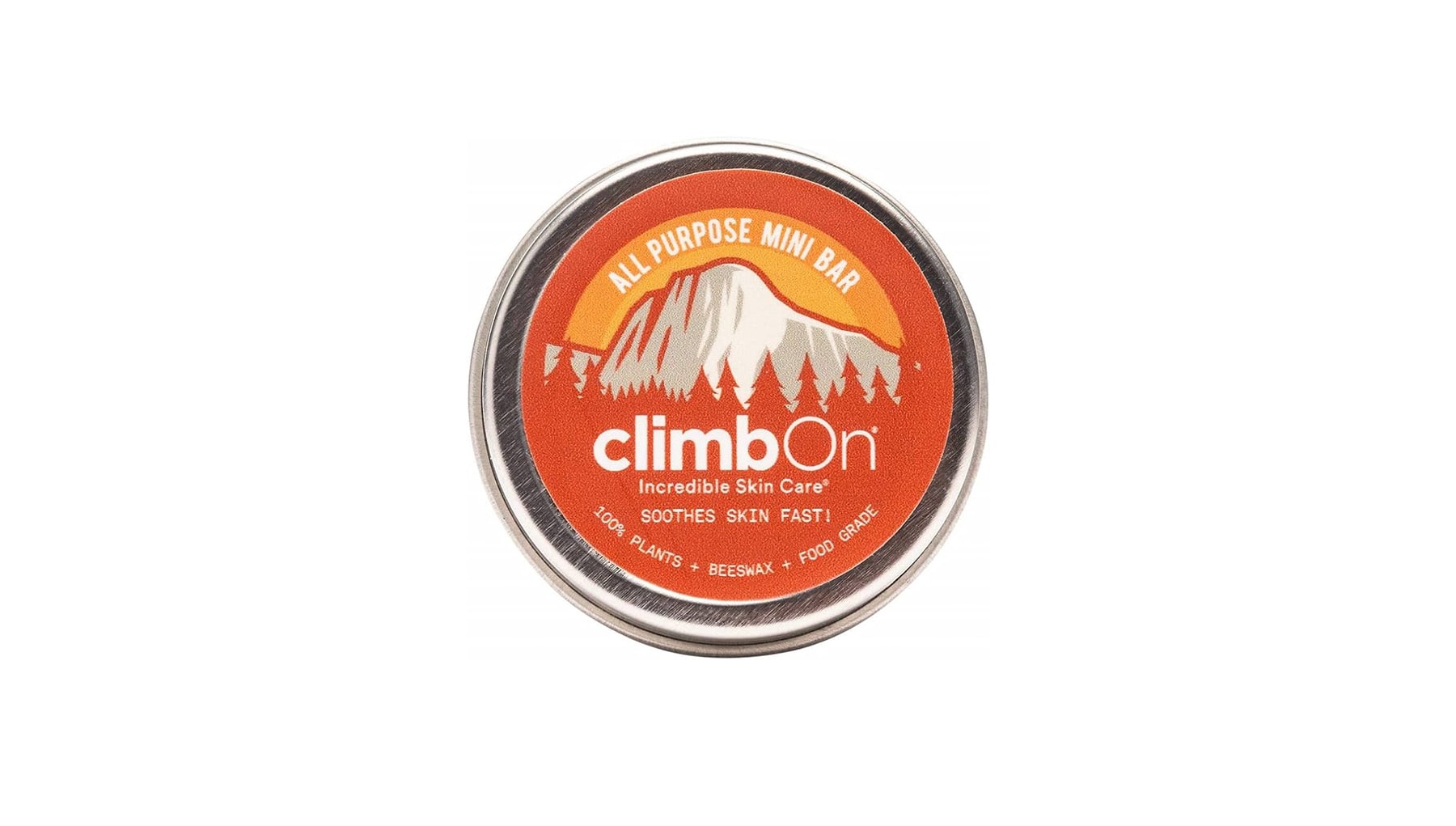
Tips for making your skin last longer
Besides following a solid skin care regimen, there are few other things you can do to ensure that you can get the most out of your skin.
Climb when conditions are best
The first thing you can do to make your skin last longer is to avoid humidity and high temps. Both factors can cause you to sweat more, which softens your skin and speeds up wear and tear. When on longer trips, look at the forecast and plan climbing and rest days accordingly. If daytime temperatures are consistently high, it would probably be best to climb early in the morning or, if bouldering, even at night. Another solid strategy is to choose climbing areas that will be in condition on the day. This can mean climbing at higher elevations, which are generally a little cooler and breezier, on warmer days and at lower elevations when conditions make that feasible.
Know when to stop climbing
The next step to skin management is to avoid taking off too much skin in a single session. The deeper you go into the epidermis, the softer and more moist your skin becomes. And the softer and more moist your skin is, the easier it is damaged and the longer it takes to repair. This can mean the difference between taking one and two (or even three rest days) just to let your skin recover. How do you tell if you are approaching that point where recovery time increases exponentially? Unfortunately, there’s no single obvious sign that you should stop. I suggest that you play it safe and stop climbing when your tips start to look pink.
Consider your choice of chalk
The type of chalk you use can have a big impact on your skin and how dry it stays during a session. You are probably already familiar with regular chalk and the many forms that it comes in (block, ball, loose), but then there is also liquid chalk, which is a combination of chalk and alcohol. The latter has two purposes: it helps paste the chalk to your skin, and it evaporates quickly when applied, drawing moisture away from the skin with it. If you have sweaty skin, you might use this type of chalk at the start of a route or occasionally swap it out for powder chalk during a boulder session. Just know the liquid chalk can also be harder on the skin than regular chalk and that it will leave it drier at the end of a session.
Wear washing up gloves
Washing liquids are excellent at removing grease and oil from dirty pots and pans. And they are also good at removing oils from your skin. To avoid losing these natural moisturizers, it’s best to wear rubber gloves when you do the washing up (something to add to your trip packing list). This is actually a good strategy regardless of whether you are trying to keep your skin dry or properly moisturized. Prolonged exposure to hot water can soften your skin, and you probably don’t want to get your hands wet if you have just applied some kind of long-acting antiperspirant. I have actually heard of climbers who wear rubber gloves in the shower for this exact reason, although that’s getting pretty extreme.
Give your skin sufficient rest between attempts
Your skin will get warmer, sweatier and softer with each attempt, so it’s important to give your skin enough time to cool down between attempts even if your muscles feel fine. Make a habit of paying attention to how your skin feels after each attempt, and with time you will develop a good awareness for how hot and tired your skin is. This is particularly useful given that everyone’s skin is different and yours might just take longer to cool down.
